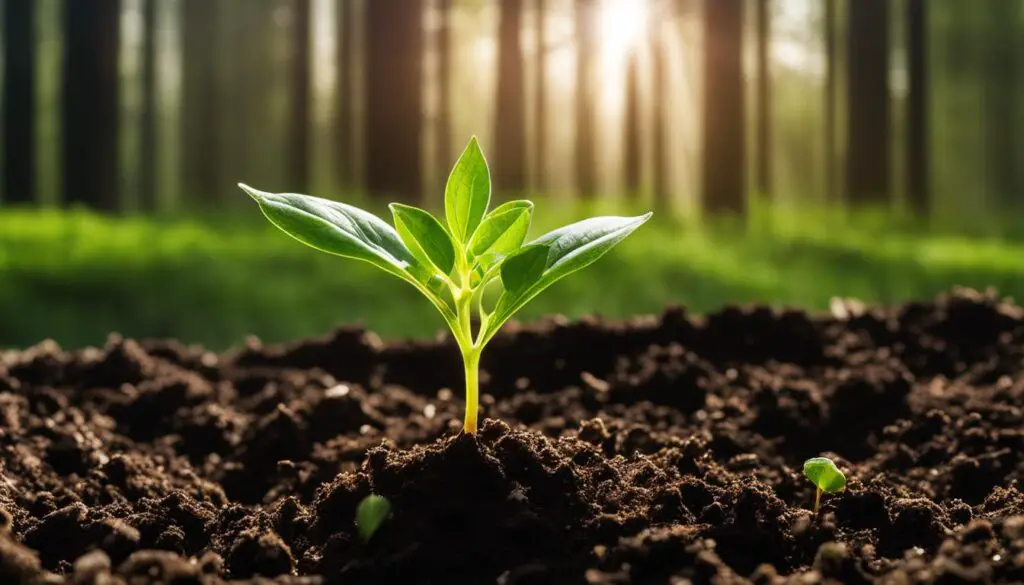Trees are magnificent organisms that have the ability to transform landscapes and provide numerous ecological benefits. Have you ever wondered how long it takes for a tiny seedling to reach its towering glory? The growth timeline of trees varies depending on several factors, including species, environmental conditions, and location. Let’s explore the fascinating world of tree growth and discover the timelines that these majestic beings follow.
Key Takeaways:
- Trees have varying growth rates, with some reaching maturity in just a few years while others take decades.
- The time it takes for a tree to grow depends on factors such as species, location, and environmental conditions.
- Factors affecting tree growth include water availability, sunlight, nutrient availability, and climate.
- Trees go through several stages in their growth process, from seed germination to maturity and eventual decline.
- The regrowth of tree branches depends on the type of cut and the tree species, with proper pruning techniques promoting healthy regrowth.
Factors Affecting Tree Growth
When it comes to the growth of trees, several factors come into play. Understanding these factors can greatly contribute to successful tree cultivation and promote optimal growth. Let’s explore the key elements that influence tree growth:
1. Water Availability
Water availability is crucial for tree growth as it facilitates the transportation of essential minerals and aids in seed germination. Trees need a sufficient water supply to ensure proper nutrient absorption and support metabolic processes. Without an adequate water source, trees may struggle to grow and develop, leading to stunted growth or even death.
2. Sunlight
Sunlight plays a vital role in tree growth as it enables photosynthesis, the process through which trees convert sunlight into energy. Through photosynthesis, trees produce glucose and oxygen, essential components for their growth and survival. Lack of sunlight can hinder photosynthesis and result in weak or stunted growth. Therefore, providing trees with adequate sunlight exposure is crucial for their healthy development.
3. Nutrient Availability
Nutrient availability, particularly nitrogen, is vital for tree growth and development. Nitrogen is an essential element that supports various biological processes in trees, including the production of chlorophyll, enzymes, and proteins. A deficiency in nitrogen can impede tree growth and lead to yellowing leaves or reduced vigor. Ensuring the soil contains an adequate supply of nutrients is important for promoting healthy tree growth.
4. Climate
Climate and seasonal variations significantly influence tree growth. Trees thrive in specific seasons when conditions are favorable for growth, such as warmer temperatures and increased sunlight. Harsh conditions, such as cold winters or extreme heat, can inhibit growth and damage tree health. Understanding the climatic requirements of different tree species is essential for successful cultivation.
To summarize, water availability, sunlight exposure, nutrient levels, and climate all play crucial roles in the growth of trees. By considering and managing these factors, tree planters can create optimal conditions for healthy and robust tree growth.
Tree Growth Stages
Trees go through several stages in their growth process. It all begins with a seed, which germinates and sprouts into a seedling. Once the shoot emerges above ground, the tree enters the sapling stage, where it grows past 3 feet tall. The next stage is maturity, where the tree starts producing fruits or flowers. Some trees, particularly those with long life spans, may enter the ancient stage when they exceed the typical age of trees of the same species. Finally, the tree reaches its decline stage due to various factors like diseases or environmental conditions.

| Tree Growth Stage | Description |
|---|---|
| Seedling | The tree grows from a seed and develops its initial roots and stem. |
| Sapling | The tree grows past 3 feet tall and establishes a sturdy trunk. |
| Maturity | The tree starts producing fruits or flowers, indicating reproductive capability. |
| Ancient | Certain long-living trees exceed the typical age of trees of the same species. |
| Decline | Due to diseases, environmental conditions, or old age, the tree’s health deteriorates. |
How Long Does It Take for a Tree to Regrow?
After a tree has undergone branch pruning, the regrowth process can vary depending on factors such as the type of cut and the specific tree species. When branches are pruned correctly, the tree can regrow its branches at a faster pace. However, if a tree is topped and branches are cut back to the trunk, it can cause significant damage and hinder proper regrowth.
“Proper pruning techniques are essential for promoting healthy regrowth after branch removal.”
Seeking professional advice from an arborist or tree care specialist is crucial to ensure proper pruning techniques and to promote healthy regrowth. They can provide valuable guidance on the ideal time to prune and the appropriate pruning methods for different tree species. By following these expert recommendations, individuals can facilitate the regrowth process and help trees regain their structural integrity.
Incorporating practices that promote overall tree health, such as regular fertilization, watering, and proper maintenance, can also contribute to faster and more successful regrowth. Providing the tree with adequate nutrients and optimal growing conditions will support its ability to recover and regrow branches effectively.
Growing Trees from Seeds
Growing trees from seeds is a cost-effective way to establish new trees. By choosing the strongest seeds and providing them with proper care, growers can produce healthy seedlings. Autumn is usually the best time to harvest seeds, but they can also be purchased from reputable stores.
When growing trees from seeds, it is important to select fully mature seeds. These seeds have the highest chances of germination and successful growth. Once the seeds are collected, they should be cleaned and dried before planting. Cleaning helps remove any remaining fruit or pulp, which can attract pests or lead to fungal diseases.
After cleaning, the seeds can be planted either directly in the ground or in containers, depending on the specific requirements of the tree species. It is important to provide the seeds with proper moisture, sunlight, and warmth for successful germination. This can be achieved by following the planting instructions for the specific tree species.
Growing trees from seeds offers several advantages. Firstly, it allows growers to select seeds from the healthiest and most desirable parent trees, ensuring the best genetic traits are passed on to the new seedlings. This can result in stronger and more resilient trees. Additionally, growing trees from seeds provides an opportunity to develop new tree breeds by cross-pollinating different varieties.

Can You Speed up Tree Growth?
While tree growth rates are largely influenced by natural factors, there are some steps that can be taken to promote faster growth. By providing the right conditions and care, you can help trees reach their full potential.
1. Ample Water: Trees need water to transport essential nutrients and support growth. During dry periods, it is important to ensure that trees receive sufficient water. Deep, infrequent watering encourages roots to grow deeper, providing stability and access to nutrients.
2. Nutrient-Rich Soil: Supplementing the soil with fertilizer can enhance tree growth. Look for fertilizers rich in nutrients like nitrogen, phosphorus, and potassium. These essential nutrients help trees develop strong roots, healthy leaves, and vibrant flowers or fruits.
3. Favorable Soil Conditions: Creating favorable soil conditions can support faster tree growth. Ensure that the soil is well-draining to prevent waterlogged roots, as this can hinder growth. Loosening compacted soil and adding organic matter, such as compost, can improve soil structure and nutrient availability.
4. Weed Control: Removing competing weeds around trees can promote better growth by minimizing competition for nutrients, water, and sunlight. Regularly inspect and remove weeds from the base of the tree, being careful not to damage the tree’s roots.
While these steps can help promote tree growth, it is important to note that trees have their own natural growth rate, which is influenced by various factors beyond our control. Providing optimal conditions and giving trees the care they need will support their growth, but significant acceleration of growth is unrealistic.
The Influence of Location and Climate on Tree Growth
The growth rate of trees is significantly affected by the location and climate in which they are planted. Various factors, such as elevation, temperature, and precipitation, can vary in different locations and impact the length of the growing season. Trees in higher elevations with cooler temperatures often have shorter growing seasons, while those in warmer areas closer to the equator may experience longer growing seasons.

Climate plays a crucial role in tree growth as it determines the availability of essential resources like sunlight, water, and nutrients. Trees planted in their native climate or in environments similar to their origin tend to thrive and grow faster. This is because they have adapted to the specific climate conditions over generations, enabling them to efficiently utilize available resources and withstand environmental challenges.
Moreover, the availability of water is particularly crucial for tree growth. Trees in regions with ample rainfall or access to irrigation systems have a better supply of water, allowing them to transport essential minerals and support optimal growth.
The Impact of Location on Tree Growth
The location of a tree also influences its growth rate. Trees planted in urban areas might face challenges due to limited space, pollution, and competition from other plants. In contrast, trees planted in rural or natural landscapes often have access to more open space, cleaner air, and fewer competing plants, enabling them to grow more vigorously.
| Location | Climate | Growth Conditions |
|---|---|---|
| Mountainous regions | Cooler temperatures | Shorter growing seasons |
| Tropical regions | Warmer temperatures | Longer growing seasons |
| Native habitats | Similar to origin | Ideal growth conditions |
| Urban areas | Varied | Challenging growth conditions |
In conclusion, the location and climate significantly impact the growth rate of trees. Understanding these influences is vital when planning tree planting initiatives to ensure optimal growth and health. By selecting appropriate tree species that are well-suited to the local climate and providing suitable growing conditions, individuals can foster strong and thriving trees that contribute to the overall beauty and sustainability of their surroundings.
The Relation Between Tree Growth Rate and Lifespan
When it comes to trees, their growth rate plays a significant role in determining their lifespan. Studies have revealed that slower-growing trees within the same species tend to live longer compared to their faster-growing counterparts. This natural balance allows trees to thrive at their own pace and adapt to their surroundings.
Slow-growing trees invest more in their structural integrity, developing stronger wood over time. This strength provides them with better resistance to diseases and pests, ensuring their longevity in challenging environments. Their deliberate growth strategy allows them to conserve energy and allocate resources efficiently to promote overall tree health.
In contrast, fast-growing trees prioritize rapid growth and may exhaust their energy reserves quickly. This can make them more susceptible to environmental factors and reduce their expected lifespan. Fast-growing trees often focus their energy on reaching impressive heights in a short period but may sacrifice durability and resilience in the process.
The table below illustrates the relationship between tree growth rate and lifespan for different species:
| Tree Species | Growth Rate | Lifespan |
|---|---|---|
| Oak Tree | Slow | Over 200 years |
| Poplar Tree | Fast | 30-50 years |
| Redwood Tree | Slow | Over 500 years |
| Willow Tree | Fast | 20-30 years |
As seen in the table, slow-growing trees such as Oak and Redwood have longer lifespans, while fast-growing trees like Poplar and Willow have shorter lifespans. It is important to note that these figures are approximate and can vary based on various factors, including environmental conditions, care, and maintenance.
By understanding the relationship between tree growth rate and lifespan, we can make informed decisions when selecting tree species for different environments. It is necessary to strike a balance between quick growth and long-term sustainability to ensure the well-being of our green spaces.
Conclusion
The growth of trees is a fascinating journey influenced by various factors such as species, location, climate, and environmental conditions. Understanding the growth timeline of trees and the factors that influence their development can help planters make informed decisions and successfully cultivate healthy trees.
Some trees can reach maturity in just a few years, while others may take decades or even centuries. For example, the Weeping Willow tree can grow over 15 feet in just five years, while the Ginkgo Biloba can take up to a century to reach its full height. The time it takes for a tree to grow is a unique process, and each species has its own pace and requirements.
To promote the growth and longevity of trees, it is essential to provide proper care. This includes ensuring sufficient water and nutrients, as well as creating ideal growing conditions. By fostering a healthy environment, individuals can contribute to the overall well-being of trees and the benefits they provide to our surroundings.
Overall, understanding the growth timeline and factors influencing tree growth is key to successful tree cultivation. By respecting the natural process and offering the necessary care, we can witness the beauty and benefits of trees as they mature and become valuable assets to our environment and communities.
FAQ
How long does it take for a tree to grow?
The time it takes for a tree to grow varies depending on various factors such as species, location, and environmental conditions. Some trees can reach maturity in just a few years, while others may take decades or even centuries.
What factors affect tree growth?
Several factors influence tree growth, including water availability, sunlight, nutrient availability in the soil, and climate. These factors play a crucial role in providing the necessary resources for trees to grow and develop properly.
What are the stages of tree growth?
Trees go through several stages in their growth process, starting from a seed, germination, and sprouting into a seedling. It then enters the sapling stage, where it grows past 3 feet tall. The tree eventually reaches maturity, producing fruits or flowers. Some trees may enter the ancient stage if they exceed the typical age of trees of the same species.
How long does it take for a tree to regrow?
The time it takes for a tree to regrow its branches depends on various factors, including the type of cut and the tree species. If a branch is pruned correctly, the tree can regrow its branches faster. However, severe pruning, such as topping a tree by cutting branches back to the trunk, can hinder proper regrowth.
Can I grow trees from seeds?
Yes, growing trees from seeds is a cost-effective way to establish new trees. By choosing the strongest seeds and providing proper care, you can produce healthy seedlings. Seeds should be picked when fully mature and prepared for planting by cleaning and drying. You can also purchase tree seeds from reputable stores.
Can tree growth be accelerated?
While tree growth rates are primarily influenced by natural factors, some steps can be taken to promote faster growth. Providing ample water, supplementing the soil with nutrient-rich fertilizer, creating favorable soil conditions, and removing competing weeds can support faster growth. However, tree growth is ultimately dependent on various natural factors and cannot be significantly accelerated.
How does location and climate influence tree growth?
The location and climate in which a tree is planted greatly influence its growth rate. Factors such as elevation, temperature, and precipitation can vary in different locations, affecting the length of the growing season. Trees planted in their native climate or in environments similar to their origin tend to thrive and grow faster.
Is there a relation between tree growth rate and lifespan?
Studies have shown that slower-growing trees within the same species tend to live longer compared to faster-growing counterparts. This is because slower-growing trees invest more in structural integrity, develop stronger wood, and have better resistance to diseases and pests. Fast-growing trees, on the other hand, focus on rapid growth and may have shorter lifespans.

